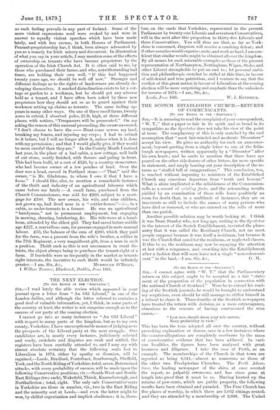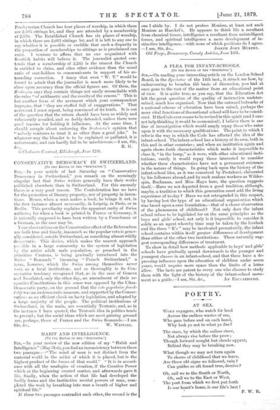(TO THE EDITOR OF THE " SPECTATOR. "]
SIR,—I' cannot agree with " W. T." that the Parliamentary return on this subject ought to be accepted as a fair "state- ment of the proportion of the population in connection with the national Church of Scotland." Were he to extend his read- ing of the Scottish journals, he would be brought to understand my scepticism, even should he still manage to stiffen himself in a refusal to share it. Three-fourths of the Scottish newspapers have treated the return with derision, as a mere extravagance, obnoxious to the censure of having contravened the wise canon,—
" Lest men should deem your tale untrue,
Keep probability in view."
This has been the tone adopted all over the country, without provoking explanation or demur, save in a few instances where the counter-allegations are completely overborne by the mass of corroborative evidence that has been adduced. In vari- ous localities, the figures have been analysed with great keenness and diligence. I take the case of Perth, as an example. The memberships of the Church in that town are reported as being 4,344,—almost as numerous as those of the other two Presbyterian Churches. The Perth Adver- tiser, the leading newspaper of the shire, at once scouted. the report, as palpably erroneous, and has since gone at length into proof that it must be so. Having hunted up the returns of pew-rents, which are public property, the following results have been obtained and paraded. The Free Church has five places of worship, in which there are 3,032 sittings rented, and they are attended by a membership of 2,648. The United Presbyterian Church has four places of worship, in which there are 2,495 sittings let, and they are attended by a membership of 2,176. The Established Church has six places of worship, in which there are 2,663 sittings let, and it is left to any one to say whether it is possible or credible that such a disparity in the proportion of memberships to sittings as is proclaimed can exist. I venture to affirm that no one acquainted with Scottish habits will believe it. The journalist quoted con- tends that a membership of 2,245 is the utmost the Church is entitled to claim, and cites other evidence than the usual ratio of seat-holders to communicants in support of his as- tounding correction. I fancy that even " W. T." would be forced to admit that the journalist is much more likely to be close upon accuracy than the official figures are. Of them, the Scotsman says they contain things not easily reconcilable with the rules " of arithmetic and the results of the census." This is but another form of the averment which your correspondent impugns, that " they are stuffed full of exaggerations." That averment I must repeat, being convinced of its truth. It is out of the question that the return should have been so widely and vehemently assailed, and so feebly defended, unless there were good reasons for holding it fallacious. At the same time, I should scruple about endorsing the Scotsman's opinion that " nobody ventures to treat it as other than a good joke." In whatever way the blunder is to be explained or palliated, it is unfortunate, and can hardly fail to be mischievous.—I am, Sir,
&c., R. G. 3 Chalmers Ceescent, Edinburgh, ,Tune 17th.



































 Previous page
Previous page